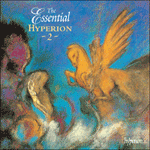
Welcome to Hyperion Records, an independent British classical label devoted to presenting high-quality recordings of music of all styles and from all periods from the twelfth century to the twenty-first.
Hyperion offers both CDs, and downloads in a number of formats. The site is also available in several languages.
Please use the dropdown buttons to set your preferred options, or use the checkbox to accept the defaults.

Whilst the subtitles go a good way to explain the content and style of the numbers in the collection, it should be noted that ‘Notturno’ bears no relationship to ‘Nocturne’ as used by Field or Chopin, but rather refers to a piece of music for evening use or with a nocturnal subject—there is nothing contemplative about ‘La regata veneziana’. Points of interest include: in No 1 a lovely bit of rhythmic complication where the left hand plays 7 against the 6/8 metre while the right hand plays six semiquavers and two duplet crotchets; in No 2 the wickedly brisk arpeggio ornaments; in No 3 the technical audacity of the second verse; in No 4 the delicacy of the emroidered accompaniment; in No 5 the crossed-hands effects; in Nos 6 and 7 the reticence to embroider at all; in No 8 the richness of the texture; in No 9, the sheer bravado; the magical cadenza in No 10; the roistering of No 11; and the expansive scope of No 12, which is practically a miniature symphonic poem in its depiction of the watching hours at sea through a storm.
from notes by Leslie Howard © 1992
Bien que les sous-titres éclairent en grande mesure sur le contenu et le style des morceaux de cette collection, il faut cependant préciser que «Notturno» n’a rien à voir avec «Nocturne», tel que le terme est utilisé par Field ou Chopin, mais se rapporte davantage à un morceau de musique à jouer le soir ou bien encore avec un sujet nocturne—il n’y a rien de contemplatif dans «La regata veneziana». Les points intéressants comprennent: dans le No 1, un ravissant moment de complication rythmique quand la main gauche joue 7 sur le mètre en 6/8 pendant que la main droite joue six doubles croches et deux noires en duolet; dans le No 2, les ornements d’arpège à la rapidité diabolique; dans le No 3, l’audacité technique de la seconde strophe; dans le No 4, la finesse de l’accompagnement décoré; dans le No 5, les effets de mains-croisées; dans les Nos 6 et 7, la réticence à la moindre décoration; dans le No 8, la richesse de la texture; dans le No 9, la pure bravade; la magique cadence du No 10; le tapage du No 11; et la large envergure du No 12, qui est pratiquement un poème symphonique miniature dans sa description des heures de quart en mer durant une tempête.
extrait des notes rédigées par Leslie Howard © 1992
Français: Alain Midoux
Zwar tragen die Untertitel erheblich dazu bei, Gehalt und Stil der einzelnen Nummern der Sammlung zu erklären, doch sollte vermerkt werden, daß „Notturno“ nichts mit dem von Field oder Chopin verwendeten Begriff „Nocturne“ zu tun hat, sondern sich auf ein Stück zur Aufführung am Abend oder mit abendlicher Thematik bezieht—„La regata veneziana“ ist alles andere als ein besinnliches Werk. Von besonderen Interesse sind unter anderem: in der Nr. 1 eine reizende rhythmische Komplikation, wenn die linke Hand mit sieben Schlägen gegen den 6/8-Takt anspielt, während die rechte Hand sechs Sechzehntel und zwei doppelte Viertelnoten ausführt; in der Nr. 2 die sündhaft schnellen Arpeggio-Verzierungen; in der Nr. 3 die technische Waghalsigkeit der zweiten Strophe; in der Nr. 4 die zart ausgeschmückte Begleitung; in der Nr. 5 die Überschlagseffekte; in Nr. 6 und 7 die Zurückhaltung, überhaupt Verzierungen anzubringen; in der Nr. 8 die üppige Struktur; in der Nr. 9 die schiere Verwegenheit; die zauberhafte Kadenz der Nr. 10; das Bramarbasieren der Nr. 11; und die große Bandbreite der Nr. 12, die mit ihrer Darstellung der Wacht auf See während eines Sturms praktisch eine Tondichtung in Miniaturform ist.
aus dem Begleittext von Leslie Howard © 1992
Deutsch: Anne Steeb/Bernd Müller
 Liszt: Complete Piano Music Liszt: Complete Piano MusicLeslie Howard’s recordings of Liszt’s complete piano music, on 99 CDs, is one of the monumental achievements in the history of recorded music. Remarkable as much for its musicological research and scholarly rigour as for Howard’s Herculean piano p ...» More |
 Liszt: Piano Music Liszt: Piano Music |
 The Essential Hyperion, Vol. 2 The Essential Hyperion, Vol. 2'More than just a highlight sampler. This is a classy collection, brought together with a great deal of care and attention to musical programming seldom found in this kind of CD … A stocking-filler any music lover would appreciate' (Scotland ...» More |

